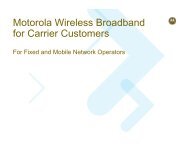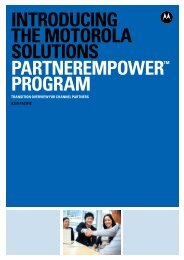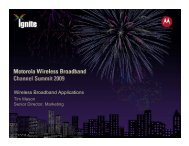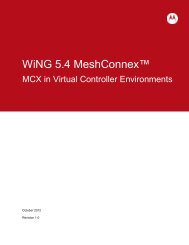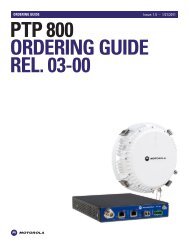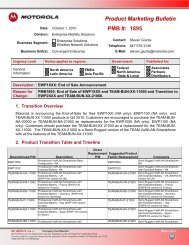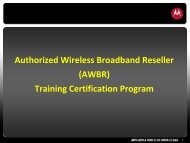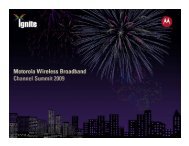<strong>PMP</strong> <strong>400</strong> and PTP 200 Series<strong>Canopy</strong> <strong>User</strong> <strong>Guide</strong> <strong>Supplement</strong>The default Range, set on <strong>the</strong> AP’s “Configuration => General” page, is 5 miles, but can be set in1 mile increments between 1 and 10 miles. The BHM performs its own ranging and so no rangeneed be set for it.If <strong>the</strong> Range is set <strong>to</strong> greater than 5 miles, <strong>the</strong>n <strong>the</strong> Downlink Data % can be a maximum of 85%,else some close-in SMs won’t register due <strong>to</strong> details of <strong>the</strong> <strong>Canopy</strong> scheduler. For example, aRange of 6 miles and a Downlink Data % of 90% is not allowed. Operationally,• if <strong>the</strong> Downlink Data % is set <strong>to</strong> greater than 85% and <strong>the</strong> user enters a range greaterthan 5 miles, <strong>the</strong> module will reset <strong>the</strong> Downlink Data % <strong>to</strong> 85%• if <strong>the</strong> range is set <strong>to</strong> greater than 5 miles and <strong>the</strong> user enters a Downlink Data % ofgreater than 85%, <strong>the</strong> module will reset <strong>the</strong> Downlink Data % <strong>to</strong> 85%.Suggested Control Slot settings as a function of number of SMs in <strong>the</strong> sec<strong>to</strong>r are shown in Table5. Generally all APs in a cluster should use <strong>the</strong> same number of control slots so as <strong>to</strong> keep <strong>the</strong>frame structures, and <strong>the</strong>reby <strong>the</strong> send and receive timing, <strong>the</strong> same.Number of SMs thatRegister <strong>to</strong> <strong>the</strong> APTable 5: Control Slot SettingsNumber of ControlSlots Recommended1 <strong>to</strong> 10 0 111 <strong>to</strong> 50 151 <strong>to</strong> 150 2151 <strong>to</strong> 200 3Note 1: Any sec<strong>to</strong>r with <strong>the</strong> Hi Priority Channel enabled on any SM should beconfigured with at least 1 Control Slot on <strong>the</strong> AP.In some cases, opera<strong>to</strong>rs may find that sec<strong>to</strong>rs with high levels of small packet requests, such asmight be seen in a sec<strong>to</strong>r handling several VoIP streams, benefit overall from slightly higherControl Slot settings. If different sec<strong>to</strong>rs require different numbers of Control Slots, <strong>the</strong> opera<strong>to</strong>rshould use <strong>the</strong> Frame Calcula<strong>to</strong>r <strong>to</strong> find a combination of settings that put “Rec SEQ Start” timeswithin 300 bit times. See section 3.6.2 on page 15 for details.Control Slots are reserved for SMs’ bandwidth requests and never handle data. A higher numberof control slots gives higher probability that an SM’s bandwidth request will be heard when <strong>the</strong>system is heavily loaded, but with <strong>the</strong> tradeoff that sec<strong>to</strong>r capacity is reduced by about 100 kbpsfor each Control Slot configured, so <strong>the</strong>re will be less capacity <strong>to</strong> handle <strong>the</strong> request.Uplink Data Slots are used first for data, but if not needed for data in a given frame can be usedby <strong>the</strong> SMs for bandwidth requests. So, even with zero control slots configured, <strong>the</strong> SMs can stillmake bandwidth requests, using any unused data slots.BHMs do not have settings for control slots, as <strong>the</strong>re is no contention on <strong>the</strong> one-<strong>to</strong>-one link.Downlink Data %, Range, and Control Slots should be set consistent with <strong>the</strong> results of anycollocation planning done using OFDM and FSK frame calcula<strong>to</strong>rs in section 3.6.2 on page 15.4.4 DFS AND REGULATORY PARAMETERS FOR 5.4 GHZ RADIOSDynamic Frequency Selection (DFS) is a requirement in several countries and regions for 5 GHzunlicensed systems <strong>to</strong> detect radar systems and avoid co-channel operation. DFS and o<strong>the</strong>rIssue 3, January 2009 Page 20 of 45
<strong>PMP</strong> <strong>400</strong> and PTP 200 Series<strong>Canopy</strong> <strong>User</strong> <strong>Guide</strong> <strong>Supplement</strong>regula<strong>to</strong>ry requirements drive <strong>the</strong> settings for <strong>the</strong> following parameters, as discussed in thissection:• Region Code• Primary Frequency• Alternate 1 and Alternate 2 Frequencies• External Antenna GainOn <strong>the</strong> AP, <strong>the</strong> “Home => DFS Status” page shows current DFS status of all three frequenciesand a DFS log of past DFS events. Note, unlike standard <strong>Canopy</strong>, <strong>the</strong> <strong>PMP</strong> <strong>400</strong> and PTP 200Series AP, SM, and BH do not offer “Whitening”, as <strong>the</strong> OFDM technology obviates <strong>the</strong> need forit.4.4.1 Background and OperationThe modules use region-specific DFS based on <strong>the</strong> “Region Code” selected on <strong>the</strong> module’s“Configuration => General” page. By directing installers and technicians <strong>to</strong> set <strong>the</strong> Region Codecorrectly, <strong>the</strong> opera<strong>to</strong>r gains confidence <strong>the</strong> module is operating according <strong>to</strong> national or regionalregulations, without having <strong>to</strong> deal with <strong>the</strong> details for each region.Available “Region Codes” include O<strong>the</strong>r, United States, Canada, Europe, Brazil, Russia, andAustralia. Opera<strong>to</strong>rs in regions or countries not listed and with requirements aligned with one of<strong>the</strong> listed countries should set <strong>the</strong> Region Code <strong>to</strong> that country. Opera<strong>to</strong>rs in regions or countrieswith no requirements for DFS should use <strong>the</strong> “O<strong>the</strong>r” Region Code.New APs and BHMs from <strong>the</strong> fac<strong>to</strong>ry will show a Region Code of “None”, and will not transmituntil <strong>the</strong> Region Code is set <strong>to</strong> a value o<strong>the</strong>r than “None”.Canada and, for new equipment, Europe, have requirements <strong>to</strong> avoid certain frequencies used bysome wea<strong>the</strong>r radar. To meet this requirement, modules set <strong>to</strong> a Region Code of Canada orEurope will display <strong>the</strong> center channel frequencies shown in Table 3 on page 13 on <strong>the</strong> AP’s andBHM’s Carrier Frequency pop-up and on <strong>the</strong> SM’s and BHS’s Frequency Scan Selection List.Table 6 shows <strong>the</strong> details of DFS operation and channels available for each Region Code,including whe<strong>the</strong>r DFS is active on <strong>the</strong> AP/BHM, SM/BHS, which DFS regulation apply, and anychannel restrictions..Table 6: <strong>Release</strong> 8.4 Operation based on Region Code5.4 GHzRegion Code 1 AP SMCenter ChannelFrequencies Available 2(MHz)United States FCC/IC DFS 3 No effect 5480 - 5710Canada FCC/IC DFS No effect 5480 – 5595, 5655 - 5710Europe ETSI DFS 4 ETSI DFS 5475 - 5595, 5655 - 5715Brazil ETSI DFS No effect 5475 - 5715Australia FCC/IC DFS No effect 5480 – 5595, 5655 - 5710Russia NA NA 5480 - 5710O<strong>the</strong>r No effect No effect 5480 - 57101. In all cases, set <strong>the</strong> Region Code <strong>to</strong> <strong>the</strong> region you are in, and <strong>the</strong>Issue 3, January 2009 Page 21 of 45






